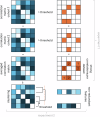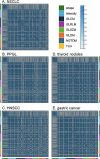Multicollinearity and redundancy of the PET radiomic feature set
- PMID: 40332568
- PMCID: PMC12559118
- DOI: 10.1007/s00330-025-11637-7
Multicollinearity and redundancy of the PET radiomic feature set
Abstract
Introduction: The aim of this study was to map multicollinearity of the radiomic feature set in five independent [18F]FDG-PET cohorts with different tumour types and identify generalizable non-redundant features.
Methods: Five [18F]FDG-PET radiomic cohorts were analysed: non-small cell lung carcinomas (N = 35), pheochromocytomas and paragangliomas (N = 40), head and neck squamous cell carcinomas (N = 54), [18F]FDG-positive thyroid nodules with indeterminate cytology (N = 84), and gastric carcinomas (N = 206). Lesions were delineated, and 105 radiomic features were extracted using PyRradiomics. In every cohort, Spearman's rank correlation coefficient (ρ) matrices of features were calculated to determine which features showed (very) strong (ρ > 0.7 and ρ > 0.9) correlations with any other feature in all five cohorts. Cluster analysis of an averaged correlation matrix for all cohorts was performed at a threshold of ρ = 0.7 and ρ = 0.9. For each cluster, a representative, non-redundant feature was selected.
Results: Seventy-two and 90 out of 105 features showed a (very) strong correlation with another feature in the correlation matrix in all five cohorts. Cluster analysis resulted in 35 and 15 non-redundant features at thresholds of ρ = 0.9 and ρ = 0.7, including 6 and 3 shape features, 4 and 2 intensity features, and 25 and 10 texture features, respectively. Seventy or 90 redundant features could be omitted at these thresholds, respectively.
Conclusion: At least two-thirds of the radiomic feature set could be omitted because of strong multicollinearity in multiple independent cohorts. More redundant features could be identified using a less conservative threshold. Future research should indicate whether multicollinearity of the radiomic feature set is similar for other radiopharmaceuticals and imaging modalities.
Key points: Question Radiomic feature sets contain many strongly correlating features, which results in statistical challenges. Findings Analysis of the correlation matrices showed that the same radiomic features were strongly correlated in five independent [18F]FDG-PET cohorts with different tumour types. Clinical relevance At least two-thirds of the radiomic feature set could be omitted, because of strong multicollinearity. More redundant features could be identified using a less conservative threshold.
Keywords: Feature reduction; Malignancies; Multicollinearity; PET-CT; Radiomics.
© 2025. The Author(s).
Conflict of interest statement
Compliance with ethical standards. Guarantor: The scientific guarantor of this publication is Floris H.P. van Velden. Conflict of interest: The authors of this manuscript declare relationships with the following companies: Sirtex, Advanced Accelerator Applications, Novartis, Ipsen, Terumo, PSI CRO, Immedica Pharma, Molecular Partners, Nuclear Research and Consultancy, and GE Healthcare. D.V. is a member of the Scientific Editorial Board of European Radiology (section: Nuclear Medicine and Molecular Imaging). As such, they did not participate in the selection or review processes for this article. Statistics and biometry: One of the authors has significant statistical expertise. Informed consent: In all but the PPGL cohort, patients signed an informed consent form. In the PPGL cohort, informed consent was waived by the Institutional Review Board due to the retrospective nature of the study and patients who objected to the use of their anonymised data were excluded. Ethical approval: Institutional Review Board approval was obtained in all five cohorts. Study subjects or cohorts overlap: Some study subjects have been previously reported in refs. [9–13, 27]. Methodology: Retrospective Experimental Multicenter study
Figures


References
-
- Limkin EJ, Sun R, Dercle L et al (2017) Promises and challenges for the implementation of computational medical imaging (radiomics) in oncology. Ann Oncol 28:1191–1206 - PubMed
MeSH terms
Substances
LinkOut - more resources
Full Text Sources

